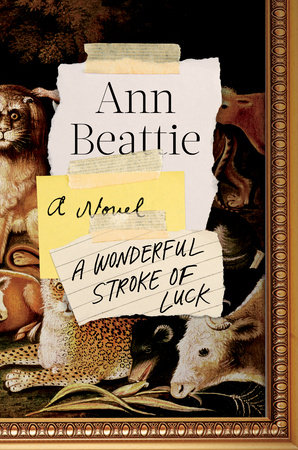
“Ladies and gentlemen, today Dr. Ha, though called upon, was unable to speak, so The Powers That Be have decreed that in the absence of the museum’s art adviser, Ms. Alwyn-Black, who is ill, I am to say something about this painting, The Peaceable Kingdom, which has newly arrived at the Harriet G. and Hubert J. Felton Gallery, on permanent loan from the cousin of an alumnus.”
LaVerdere turned to LouLou. “Ms. Sils, if you could delay your boot repair until I have finished? Thank you kindly. To continue: It will be obvious that a version of Eden exists before us, where animals antagonistic to one another stand contentedly side by side, a small figure assumed to be the painter, Mr. Hicks, among them. Mr. Hicks was a Quaker, as you may know from the handout photocopied by Tessie. I’ve read a bit about Mr. Hicks, and it seems that in spite of his projected vision of peace and happiness, which makes him a premature hippie— Aqua, you are the perfect audience; thank you—he became pained as the Quaker religion split into factions: what we would call “orthodox,” versus a more rural, conservative faction, with which Mr. Hicks, as a former farmer and sign painter, felt personally affiliated.
“In his old age, he came to believe that these differing views would not be reconciled. I suspect you will find out that this is a common attitude, one arrived at quite often by anyone who thinks, for example, that in our time the Arabs and the Jews must inevitably reconcile. This interjects a moment of current affairs, meant to jolt you awake, since I won’t assume you have freely gathered here, or that you care about a depiction of lions and sheep, with a conventionally beautiful sky spread overhead. Yes, Ms. Hayashi-Myers?”
“Must we factor in that nature’s beauty is impermanent, which colors perception, so to speak?”
Ben took a deep breath. To avoid answering Akemi’s impossible-to-answer questions, some of the teachers resorted to calling on her classmates to respond, instead. Now, though, no one replied, though LaVerdere coughed into his hand.
“Let us look at this painting—its subject matter; our arguably unreliable information about a lack of peacefulness within the painting’s creator. While that hardly makes it Munch’s The Scream—thank you again, Aqua—may I suggest that ultimately, anecdotal information makes our contemplation something other than it might have been, allocating three to five seconds to walk past it in a museum. Or, in this case, in a Park Avenue condo. Though we cannot detect conflict, the vision portrayed, the idealization, is to my eye a bit too remote from reality to be convincing.
“And while I know nothing about the painter’s intentions, I do know that there are sixty-some variations on this painting, which might be interpreted at least two ways: that the painter is insisting—which always makes us think we might be encountering someone’s defense system, hmm?—or that the painter has a specific ambition he is unable to accomplish. Of course we would not want Mr. Hicks to say, ‘Aha!’ and destroy the succession of paintings leading up to this one. Yet, ironically, amid the ostensible ‘peace’ of the painting, its emotional underpinnings may be quite varied, among them obsession, frustration, even desperation.
“Without adding more biographical information, let me suggest that while certain writers and musicians are approved of because they have a so-called vision that they return to, it is also a risky endeavor, because quantity may raise questions rather than reinforcing the impact. Does one’s adamancy convince, or suggest a possible struggle within the artist that becomes part of the art itself—perhaps inseparable from it? Something we are no doubt still thinking about, following our trip to a so-called real art gallery last year, under the supervision of Ms. Alwyn-Black, as I’m sure all of you will remember: another highlight of your broad—I imply no pun here—education at Bailey Academy.”
Phillip Collins got it. He snorted.
“Thank you for your time, ladies and gentlemen,” LaVerdere said, his face becoming animated. “Let us hope our museum director makes a quick recovery so that she can preside at the upcoming dinner thanking our benefactor. Study those animals and marvel at their slightly romanticized accuracy, but wonder whether within those depictions we don’t sense a personal projection not to be satisfied by this painting, or by its reiterations.”
__________________________________
From A Wonderful Stroke of Luck by Ann Beattie, published by Viking, an imprint of Penguin Publishing Group, a division of Penguin Random House, LLC. Copyright © 2019 by Ann Beattie


